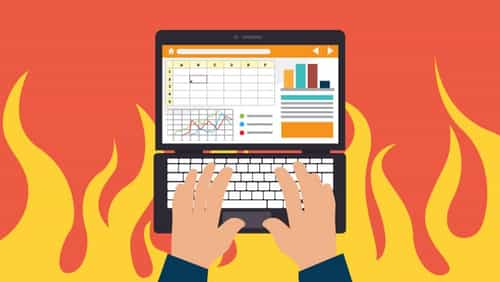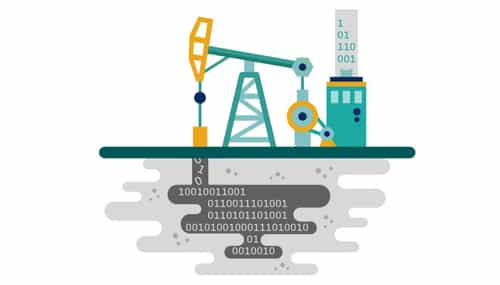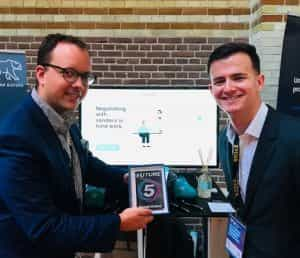About a month’s time has passed since Kodiak Hub had the opportunity to attend DPW 2019 as one of the 20 digital procurement growth ventures selected to participate in the RiSE program.
As put by Founder of Azul Partners Inc, Jason Busch, “On just about every count, DPW was a runaway success” (SpendMatters 2019).
The event was packed with killer keynotes, fantastic discussions with other software vendors and consultants, top procurement practitioners from global organizations and maybe even a beer, or two.
I’ve had time to reflect on the hurricane of impressions I was subject to at DPW 2019, and now it’s time to stoke the coals and grill my emotions to some appetizing conclusions.
9 Big Takeaways After Attending Digital Procurement World 2019
1. We’re Cannibalizing the Market
At DPW 2019, Kodiak Hub had the opportunity to stand next to some of the most innovative digital procurement solution providers from all over the globe.
As a solution provider at an event, you often find yourself wedged in between competitors to your left and right. There’s no way to avoid it. You smile, shake hands, speak about your organization (even though you’ve already thoroughly researched each other in a competitor analysis). On some subconscious level — as you smile and nod and trade niceties — your mind wanders to a scene from a wild west movie where you’re drawing down delivering a line like, ‘This town ain’t big enough for the both of us’.
In reality, this town and market — of procurement organizations looking for solution providers — is plenty big enough for everyone. The more events one attends, and the deeper conversations get about each others solutions, you start to realize, there are more synergies than overlaps.
But, we continue to cannibalize the market.
There’s a multitude of eSourcing & eAuction solutions as there are Spend solutions; as these are areas where procurement has digitalized heavily in the past years. Show me two of those solutions that are providing the same service and I’ll show you 10 others that are doing things differently. We’re moving into an era of best-of-breed vs S2P digital procurement ecosystems, and even the S2P providers have gaps. When will we stop trying to beat each other out, and start realizing our differences in order to build stronger solutions together?
2. All-In-One Isn’t for All
S2P (Source-to-Pay)solutions aren’t as prevalent to adopt as they were once before.
Procurement professionals have signaled to the market that they are ready to implement best-of-breed solutions instead of locking their processes into one single solution. The market is moving from an all-in-one mindset, and beginning to accept the methodology of building an ecosystem rather than laying that ‘safe SAP foundation’. Foundation is good but typically made of cement. Are you getting your feet stuck before it dries?
3. Excel Is Our Biggest Competitor
Me: ‘So how are you working with SRM today? Do you have any existing solutions?’
Practitioner: ‘Well, from what you describe in your solution, we have a similar process, but we’re just using Excel & Mail. And, then we visualize that data after our Sourcing Analysts put it into a BI solution.’
In the space of SRM, SPM, Supplier Collaboration, Category Management, and Risk Management there is a standardized solution that the market has accepted as ‘good enough’; its name is Excel & Mail.

While these work tools are perfectly compatible with managing risk, completing SRM tasks, and taking care of category management, are you really happy about being stuck in excel hell?
Practitioner after practitioner of some of the largest and most mature procurement organizations in the world answered the same thing. And, it’s not weird at all, because our biggest competition isn’t the other providers on the market, but excel and mail. Unfortunately, these exact same work tools you’ve trusted for so long could be the one thing that stands in your way from creating a scalable digital procurement ecosystem.
Procurement Leaders’ research has shown that “For workflow assignment and supplier relationship management (SRM), more than 60% have no tools or rely primarily on improvised systems using Microsoft Office. For risk management, stakeholder management, category management, and information sharing, that figure rises to more than 70%. Unlike cloud-based technologies, traditional Microsoft Office tools don’t allow real-time collaboration” (Bain & Company 2018).
This statistic shows, it’s not just you. So, don’t worry! But, ask yourself, are you looking to stay in your comfort zone or preparing yourself for the future?
4. Data Is Oil

Like I heard Bob Murphy, CPO at IBM, say ‘Data is the new oil’.
It’s plentiful, it’s rich and everyone wants to get their hands on as much as they possibly can.
Unlike oil, Data isn’t a depleting resource, but rather growing exponentially with a great abundance. The procurement lifecycle is filled with hundreds if not thousands of valuable data points spanning from supplier master data to spend to lead times. Many datasets are hard and numerical, and others are soft and qualitative.
But, procurement data is only as good as the means to utilize it, in the same way, oil is only as valuable as the rigs that drill it. Without the right tools, data remains underground, completely invisible to the teams trying to utilize it. Whatever kind of procurement data it is that you’re looking to gather/utilize, there’s likely a solution on the market to help you dig it up.
5. Start Somewhere
Your digital procurement roadmap is important.
Following your roadmap is a great way to keep your digital needs on track, and ensure that you’re building a solid infrastructure, and scalable ecosystem of procurement solutions. At the same time, your digital procurement roadmap may be the one thing that’s keeping you from actually digitalizing your procurement processes and strategies.
Over 80% of procurement leaders have defined a clear digital procurement strategy, but “less than one-third believe that their strategy will enable procurement to deliver significantly on its objectives and improve enterprise value” (Deloitte CPO Survey 2018).
Skepticism from procurement leaders surrounding updating and digitalization of procurement solutions isn’t strengthening the case for digitalization in the organization.
Digitalization requires change, and change requires risk. Procurement teams aren’t super fond of taking risks. In fact, taking risks goes against the very fibers of what it means to be a procurement professional. Then again, innovation doesn’t happen if a strategy never turns to action.
A resounding theme at DPW 2019 was to ‘start somewhere’ in the adoption of digital procurement solutions. BCG’s 2019 report about The Most Innovative Companies 2019 stated that, amongst strong innovators, “75% report using incubators, 81% leverage academic partnerships, and 83% partner with other companies” (BCG 2019).
This goes for procurement teams too!
So, utilize your digital roadmap & strategy, run gap analyses, request demos with solution providers and choose shortlists of top providers. Be transparent and put your challenges in front of innovative solution providers after you’ve qualified their ability to deliver value. There are a good chance solution providers will have some answers to the headaches your excel sheets & homegrown solutions are causing, and/or they’ll be willing to work with you in an agile framework to create a solution. Take a chance — not a risk — and get started somewhere.
6. Artificial Intelligence Is Almost Real
As data becomes more and more robust, solution providers that utilize the power of innovative technology such as artificial intelligence & machine learning are becoming all the more real.
Shout out to BidOps, who won the ‘Pitch’ session at DPW 2019, and was named as one of SpendMatters Future 5.

The hype isn’t just hype anymore. Artificial Intelligence is very real, and top tier procurement teams are beginning to leverage the value of this technology to become more predictive in negotiations, tenders, production, etc.
Returning to the study by BCG, The Most Innovative Companies 2019, it was named that, “Nine out of ten respondents in our current survey say that their companies are investing in AI, and more than 30% expect AI to have the greatest impact of any innovation area on their industry over the next three to five years” *(BCG 2019).
Not so science fiction anymore, huh?
7. Don’t Get Blinded by ‘Digital Transformation’
“A recent survey of directors, CEOs, and senior executives found that digital transformation (DT) risk is their #1 concern in 2019. Yet 70% of all DT initiatives do not reach their goals. Of the $1.3 trillion that was spent on DT last year, it was estimated that $900 billion went to waste” (HBR 2019).
The question is, is digital transformation the issue, or are the expectations of it’s impact the real reason why investments are going to “waste”. The semantics of digital transformation communicate that a digital technology’s presence and application will transform the business or function. Sounds good, right? Maybe so, but digital transformation is also loaded with presumptions of large ROI, and therefore statistics like the one above from HBR’s article have begun to surface.
Just like it’s important to ‘start somewhere’ there’s value in placing ‘digital transformation’ on the buzzword reserve shelf and start focusing on digitalization of disciplines within procurement where you’ll start seeing an impact in the short term.
To stop getting bogged down in the enormity of digital transformation, and start focusing on real action points, HBR offered up 5 key lessons:
- Figure out your business strategy before you invest in anything.
- Leverage insiders.
- Design customer experience from the outside in.
- Recognize employees’ fear of being replaced.
- Bring Silicon Valley start-up culture inside.
8. Our Secret Society
Procurement is a weird little world.
If you don’t agree with that, then you’re likely on the outside looking in. The more events I attend, the more I realize, procurement is like it’s own little secret society.
Procurement pros have their own language and exist in a rather homogenous demographic.
DPW 2019 was slightly outside of the box of your typical procurement event. Not every practitioner was wearing a navy blue suit, but the usual characters were still in attendance using the same terminology during the same analytically introverted dialogues.
Do we, who belong to this weird little world, not know any better, or is our language a thinly veiled defense mechanism…
“Maybe we are camouflaging procurement with language: if no-one else understands what we do (or say) we will be safe from being replaced or consumed by other functions. Terms, idioms, expressions, acronyms, and abbreviations, are all part of a specialist language that belongs to one group of people, in this case within a specific industry. Keeping the specialist knowledge inside the heads of the owners is a safety mechanism: if those on the outside can’t speak the language, they can’t get in” (Clinton 2015).
Do you know the password?
9. Things Are About to Go Really Fast
The last keynote of the event was Gerd Leonhard, Futurist.
I admit I’m typically slightly allergic to people that give themselves titles like ‘Futurist’, considering there’s always a book for sale after their keynote, but Gerd was of a different breed.
His speech knocked my socks off, put them back on and made me feel like I could walk on hot coals. Gerd’s keynote was packed with appealing graphics, interesting stories, and mindblowing statistics. The one thing that stuck with me from his speech… things are about to go really fast when it comes to human & technological development.
Below is a snippet from an article he published in Forbes:
“Humanity will change more in the next 20 years than the previous 300 years."
It’s a big call, and I will happily admit that I’ve had some people snicker at this statement. “You’re grandstanding!” they say, “That’s unbelievable!” And whilst it may feel like a dramatic statement, I stand by it. If anything, I consider it to be an understatement when you assess the reality of exponential and combinatorial technological change. When AI (artificial intelligence) meets HI (human intelligence), business, as usual, is dead. The effect of the changes we’re witnessing surpass pivotal historical moments such as the industrial revolution, or the invention of the printing press. Technology will no longer remain just outside of us, but it is relocating inside of us in the form of wearables, BCIs, nanotechnology, and human genome editing. What we are experiencing is a shift in the very definition of what it means to be human. Before now, technological revolutions have involved the material world around us, but now that infotech and biotech are converging and technology starts going inside of us, the changes will be unlike anything humankind has ever seen before” (Leonhard 2019).
Until next time.
Original Post by Samuel Jenks, Chief Revenue Officer of Kodiak Hub.











